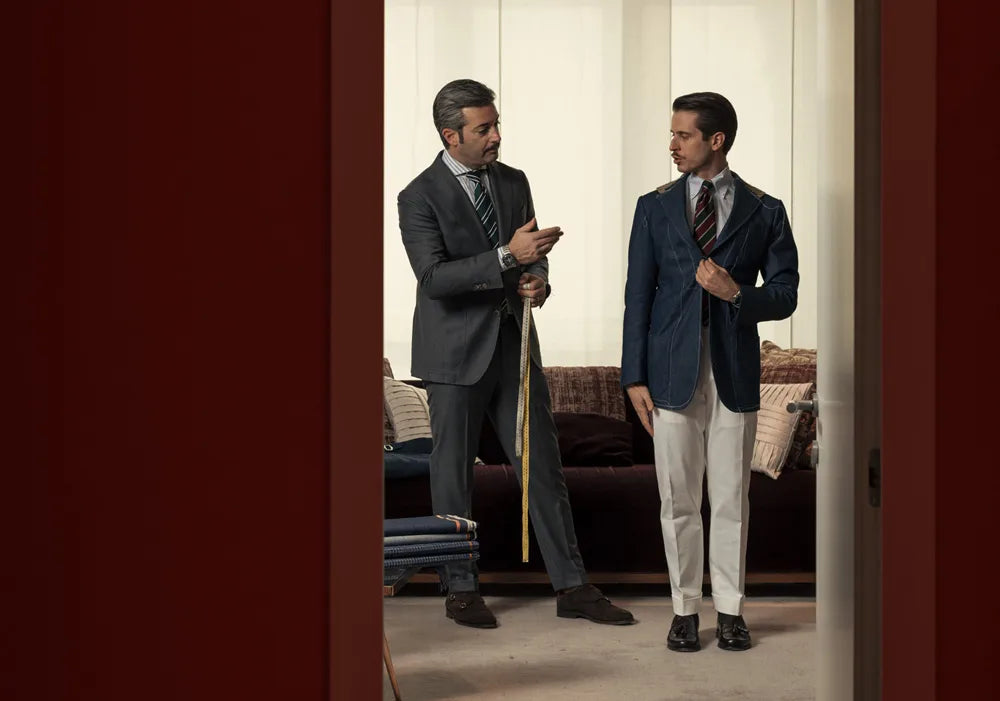As summer approaches and with it the typical scorching climate of the season, men who have the need to adopt formal looks feel under pressure: to prefer comfort or elegance?
There is one fabric, however, that since the beginning of the 20th century seems to have convinced everyone that comfort and refinement combined with a pinch of originality can easily coexist.
In fact, “ Seersucker ” is a very pleasant fabric to wear and is particularly suitable for the summer season. It stands out from the others for its particular gathered and embossed appearance that makes it suitable for the hot season as it remains detached from the skin allowing it to breathe.
Invented in India, the fabric became known by its Persian nickname, “shir” and “shekar,” literally meaning “milk and sugar,” referring to its combination of smooth and rough pinstripe pleats.
The effect was originally produced using warps of silk and cotton… nowadays, however, cottons are commonly used instead of silk through a clever alternation of narrower and wider warps.
The benefits are twofold. First, seersucker doesn't wrinkle as much as regular fabric (technically, it's already wrinkled), which creates greater durability and makes it ideal for travel. Not only that, its natural gather creates space between the fabric and the layer underneath, allowing for more airflow and breathability.
History of Seersucker
The crinkled fabric was first adopted throughout the British colonies in the early 20th century, where its properties were ideal for warmer climates, and was later chosen by workers who wore functional seersucker workwear during the summer months: shirts, work jackets, overalls and peaked caps were all made in a heavy version of seersucker.
In 1909, seersucker was introduced to the tailoring world by American manufacturers Haspel as the latest in summer suiting fabric.
On the big screen, Gregory Peck’s character of Atticus Finch brought the seersucker suit into the mainstream as he defended Tom Robinson in “To Kill a Mockingbird.” Peck sported a three-piece version, wearing it in proportions larger than his frame, which were in keeping with the tailoring standards of the time.

Seersucker Today
Over time, the fabric was ironically adopted by Ivy League college kids, who wore it in an overtly preppy way, subverting its social and economic history. As it progressed from college graduates to politicians, it slowly came to represent the leisure suit of the upper classes. 
Today, the fabric is once again a must-have option for warmer months; a more contemporary and arguably easier-to-wear alternative than linen. Key to this renaissance has been its adoption by contemporary menswear designers. From casual brands to bespoke tailoring, seersucker can adapt to a wide range of looks and personal styles. 
Our proposals
We at Virum also chose it because of its incredible versatility and comfort, which make it intelligent and usable in various contexts: from the most formal to the most casual.
We make our Seersucker suits using fabrics from the Cacioppoli Napoli 1920 drapery, synonymous with guarantee and excellent quality.
The dress you see in the photo was specifically made for a summer wedding in a seaside location, perfect for a formal event where comfort and breathability are also necessary.
But seersucker can also be used in less formal contexts and accessorized to make it more casual: with a pair of white sneakers, with jeans or with tailored polo shirts.
In fact, Virum also offers its customers the creation of trousers, shorts and blazers in Seersucker that can become passe-partout garments in every man's wardrobe.

